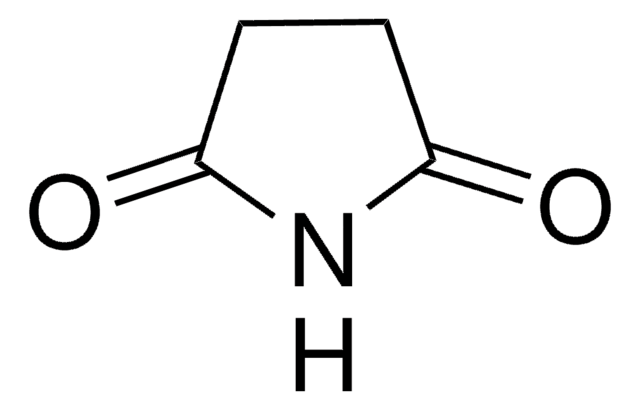If this product has an expiration or retest date, it will be shown on the Certificate of Analysis (COA, CofA). If there is no retest or expiration date listed on the product's COA, we do not have suitable stability data to determine a shelf life. For these products, the only date on the COA will be the release date; a retest, expiration, or use-by-date will not be displayed.
For all products, we recommend handling per defined conditions as printed in our product literature and website product descriptions. We recommend that products should be routinely inspected by customers to ensure they perform as expected.
For products without retest or expiration dates, our standard warranty of 1 year from the date of shipment is applicable.
For more information, please refer to the Product Dating Information document: https://www.sigmaaldrich.com/deepweb/assets/sigmaaldrich/marketing/global/documents/449/386/product-dating-information-mk.pdf
Kluczowe dokumenty
439215
Tetrahydrofuran
≥99.9%, suitable for HPLC, inhibitor-free
Synonim(y):
THF
About This Item
Polecane produkty
Nazwa produktu
Tetrahydrofuran, suitable for HPLC, ≥99.9%, inhibitor-free
klasa czystości
HPLC grade
Poziom jakości
gęstość pary
2.5 (vs air)
ciśnienie pary
114 mmHg ( 15 °C)
143 mmHg ( 20 °C)
Próba
≥99.9%
Formularz
liquid
temp. samozapłonu
610 °F
granice wybuchowości
1.8-11.8 %
metody
HPLC: suitable
zanieczyszczenia
≤0.015% peroxide (as H2O2)
<0.02% water
pozostałość po odparowaniu
<0.0005%
współczynnik refrakcji
n20/D 1.407 (lit.)
bp
65-67 °C (lit.)
mp
−108 °C (lit.)
rozpuszczalność
H2O: soluble
gęstość
0.889 g/mL at 25 °C (lit.)
λ
H2O reference
absorpcja UV
λ: 212 nm Amax: 1.0
λ: 250 nm Amax: 0.180
λ: 300 nm Amax: 0.020
λ: 350-400 nm Amax: 0.005
ciąg SMILES
C1CCOC1
InChI
1S/C4H8O/c1-2-4-5-3-1/h1-4H2
Klucz InChI
WYURNTSHIVDZCO-UHFFFAOYSA-N
Szukasz podobnych produktów? Odwiedź Przewodnik dotyczący porównywania produktów
Opis ogólny
Zastosowanie
- Tworzenie polimerów diacetylinowych.[4]
- Polimeryzacja RAFT p-acetoksystyrenu.[5]
- Synteza di-tert-butylo-fosfinoferrocenu.[6]
- Jako rozpuszczalnik fazy ruchomej w wysokosprawnej chromatografii cieczowej.[7]
- Jako rozpuszczalnik w przygotowaniu powlekanego spinowo eteru dekanowego poli(bisfenolu A).[8]
- Tworzenie butyrolaktonu (BTL) metodą zielonego utleniania.[9]
- Jako rozpuszczalnik do depolimeryzacji ligniny w celu wyizolowania monomeru fenolowego.[10]
polecane
Hasło ostrzegawcze
Danger
Zwroty wskazujące rodzaj zagrożenia
Zwroty wskazujące środki ostrożności
Klasyfikacja zagrożeń
Acute Tox. 4 Oral - Carc. 2 - Eye Irrit. 2 - Flam. Liq. 2 - STOT SE 3
Organy docelowe
Central nervous system, Respiratory system
Zagrożenia dodatkowe
Kod klasy składowania
3 - Flammable liquids
Klasa zagrożenia wodnego (WGK)
WGK 1
Temperatura zapłonu (°F)
-6.2 °F - closed cup
Temperatura zapłonu (°C)
-21.2 °C - closed cup
Środki ochrony indywidualnej
Eyeshields, Faceshields, Gloves, type ABEK (EN14387) respirator filter
Wybierz jedną z najnowszych wersji:
Masz już ten produkt?
Dokumenty związane z niedawno zakupionymi produktami zostały zamieszczone w Bibliotece dokumentów.
Produkty
Polar graphitic carbon enables UHPLC separation of highly polar pesticides, herbicides, and Vitamin D metabolites, advancing liquid chromatography capabilities.
-
How can I determine the shelf life / expiration / retest date of this product?
1 answer-
Helpful?
-
-
How is shipping temperature determined? And how is it related to the product storage temperature?
1 answer-
Products may be shipped at a different temperature than the recommended long-term storage temperature. If the product quality is sensitive to short-term exposure to conditions other than the recommended long-term storage, it will be shipped on wet or dry-ice. If the product quality is NOT affected by short-term exposure to conditions other than the recommended long-term storage, it will be shipped at ambient temperature. As shipping routes are configured for minimum transit times, shipping at ambient temperature helps control shipping costs for our customers. For more information, please refer to the Storage and Transport Conditions document: https://www.sigmaaldrich.com/deepweb/assets/sigmaaldrich/marketing/global/documents/316/622/storage-transport-conditions-mk.pdf
Helpful?
-
Active Filters
Nasz zespół naukowców ma doświadczenie we wszystkich obszarach badań, w tym w naukach przyrodniczych, materiałoznawstwie, syntezie chemicznej, chromatografii, analityce i wielu innych dziedzinach.
Skontaktuj się z zespołem ds. pomocy technicznej










